 |
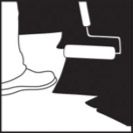 Seal the Deal
Seal the Deal
ChemMasters Newsletter: Vol 1 Issue 3
What Are "VOC's"?
As more states enact stricter air quality regulations, the term “VOC” is becoming a greater part of our everyday vocabulary. But what exactly is a “VOC”?
VOC is an acronym for Volatile Organic Compound. That’s a mouthful, but what does it mean? VOC’s are carbon based (organic) solvents that evaporate (volatilize) under normal atmospheric conditions and have the ability to photo-react when exposed to sunlight. This reaction creates low-level ozone, a major component of smog.
Smog is associated with causing asthma, bronchitis, and emphysema. Smog poses a health threat to the young, elderly, and those suffering from cardiovascular disease. And as anyone who has flown into some major metropolitan cities (like Los Angeles) can attest, smog is a real problem for everyday citizens. As a result, many states have enacted strict VOC regulations, limiting the level of photo-reactive solvents manufacturers can use in coatings.
These states have also published a list of VOC “exempt” solvents that have limited photo-reactivity, and do not contribute to smog formation. Unfortunately, VOC exempt solvents are not as user friendly, are associated with conditions such as fast evaporation and bubble formation, and increased product costs. Every coating manufacturer is limited to the same exempt solvents. If it doesn’t appear on the list, it isn’t VOC exempt.
VOC’s are measured in grams per liter (g/L), and the Federal limit for cure & seals is 700 g/L. Various states and groups of states, including California, the Ozone Transport Committee (OTC) states, the Lake Michigan Air Directors Consortium (LADCO) states, and Canada have enacted more restrictive VOC limits of 350 g/L for cure & seals (400 g/L for sealers). These limitations impact all paints and coatings, not just cures & sealers.
Examples of both Federal and “low” VOC limits for some common products include:
| VOC Limit | Cure & Seal | Film Forming Sealer | Penetrating Waterproofer | Form Release |
| Federal | 700 g/L | 700 g/L | 600 g/L | 450 g/L |
| “Low-VOC” | 350 g/L | 400 g/L | 250 g/L | 250 g/L |
The listing of states which adhere to the higher Federal allowances includes:
| Alabama | Alaska | Arkansas | Colorado | Florida | Georgia |
| Hawaii | Idaho | Iowa | Kansas | Kentucky | Louisiana |
| Michigan | Minnesota | Mississippi | Missouri | Montana | Nebraska |
| Nevada | New Mexico | North Carolina | North Dakota | Oklahoma | Oregon |
| South Carolina | South Dakota | Tennessee | Texas | Utah | Vermont |
| Washington | West Virginia | Wisconsin | Wyoming |
And states with the more restrictive VOC limitations are:
| Maricopa County (AZ) | California (various air districts) | Connecticut | Delaware |
| District of Columbia | Illinois | Indiana | Maine |
| Maryland | Massachusetts | New Hampshire | New Jersey |
| New York | Ohio | Pennsylvania | Rhode Island |
| Virginia (specific counties) | Canada |
The fines and criminal penalties for use of non-compliant products are substantial, so it’s imperative that you know what products can and can’t be used in your state.
Here are a few things to keep in mind when choosing any solvent-based product:
- Make certain the product you intend to use is VOC compliant within the state it’s intended to be used. This is particularly important if you’re traveling to a remote jobsite in a state whose VOC laws you may not know.
- Low VOC coatings often require different application techniques.
Call or write the ChemMasters’ technical department for a complete list of VOC limitations in your state, or if you have any questions about which ChemMasters product is compliant.
ChemMasters Low-VOC Solvent-Based Workhorses:
 Polyseal™ EZ
Polyseal™ EZ
Bubble Resistant Low-VOC Cure and Seal
Polyseal EZ is a proprietary formulation that resists bubble formation, cobwebbing, and stringing commonly associated with low-VOC cure and seals.
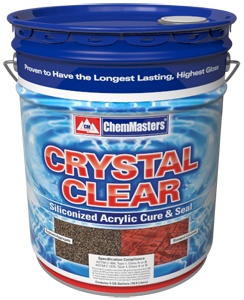 Crystal Clear-A
Crystal Clear-A
Low-VOC Siliconized Acrylic Concrete Cure & Seal
Crystal Clear-A is premium quality, super high gloss, non yellowing, curing and sealing compound. Crystal Clear-A is a state-of-the-art proprietary formulation which creates the highest gloss possible on concrete.
 Traz 25-A
Traz 25-A
Low-VOC Solvent-Based Methyl-Methacrylate Concrete Sealer
Traz 25-A is a film forming sealer for concrete and masonry. Traz 25-A is formulated with methyl methacrylate polymers that develop high gloss and are more chemical resistant than standard acrylic sealers.
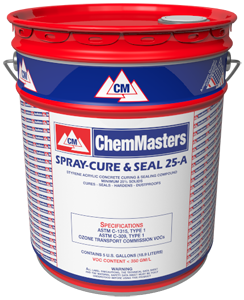 Spray-Cure and Seal 25-A
Spray-Cure and Seal 25-A
Low-VOC Styrenated Acrylic Cure & Seal for Broom Finished Concrete
Spray-Cure & Seal 25-A is a styrene acrylate
copolymer, membrane forming curing and sealing
compound for concrete.
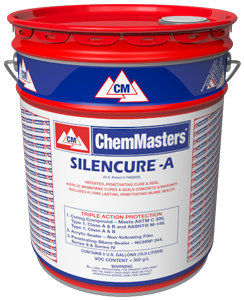 Silencure™-A
Silencure™-A
Low-VOC Penetrating Silane Cure and Seal for Broom Finished Concrete
Silencure-A is a solvent-based, pure acrylic copolymer curing and sealing compound for concrete.
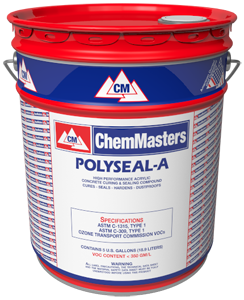 Polyseal™-A
Polyseal™-A
Low-VOC Pure Acrylic Concrete Cure & Seal
Polyseal™ A is a high solids, high performance
concrete curing and sealing compound. This
state-of-the-art proprietary formulation completely
resists discoloration from ultraviolet light
exposure, creating a glossy membrane which
remains clear throughout its service life.
 Stamped & Decorative Concrete Sealer 400A
Stamped & Decorative Concrete Sealer 400A
Slow Evaporating, Low-VOC High Gloss “Wet Look” Sealer
Film forming sealer manufactured to provide 200-300% more working time on stamped, exposed aggregate,
and other decorative concrete than traditional
low-VOC sealers.
Silencure, Polyseal, Traz, Aquanil, Spall Guard, Chemisil, EZ Strip Cure, SafeSeal, Spray Film, DuraShield SRT, Slip Stop and Exposee are trademarks of ChemMasters, Inc. ChemMasters and Safe-Cure are registered trademarks of ChemMasters, Inc.
300 Edwards Street, Madison, Ohio 44057
Phone 440.428.2105 - 800.486.7866
Fax 440.428.7091
Silencure, Polyseal, Traz, Aquanil, Spall Guard, Chemisil, EZ Strip Cure, SafeSeal, Spray Film, DuraShield SRT, Slip Stop and Exposee are trademarks of ChemMasters, Inc. ChemMasters and Safe-Cure are registered trademarks of ChemMasters, Inc.

Phone 440.428.2105 - 800.486.7866
Fax 440.428.7091
ERISA Documents for Welfare Benefit Plan
